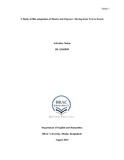| dc.contributor.advisor | Ahmed, Nawshaba | |
| dc.contributor.author | Nahar, Ashrafun | |
| dc.date.accessioned | 2016-01-12T12:58:31Z | |
| dc.date.available | 2016-01-12T12:58:31Z | |
| dc.date.copyright | 2015 | |
| dc.date.issued | 2015-08 | |
| dc.identifier.other | ID 13163010 | |
| dc.identifier.uri | http://hdl.handle.net/10361/4764 | |
| dc.description | This thesis is submitted in partial fulfillment of the requirements for the degree of Master of Arts in English, 2015. | en_US |
| dc.description | Cataloged from PDF version of thesis. | |
| dc.description | Includes bibliographical references (page 48-51). | |
| dc.description.abstract | Literary adaptation has reached a new dimension in the postmodern era. Literary adaptations have gone through various technical and aesthetic changes over the last century and are done taking from the classical literary works to the contemporary literature as well. Almost all film industries around the world are interested in film adaptations nowadays. Because of the interest and innovation in adaptations as a film mode, it has become more of a vice-versa relation between the two forms of art. Not only films are being made taking the narrative from popular or classical literature, but literatures are also inspired and are being written based on films and Television sitcoms. These adaptations have dynamic impact on both the medium of art, cultural perception and the recipients. Since recreation and entertainment through TV and motion pictures are such a big part of postmodern life, the practice of adaptation demands cultural re-reading and research to establish the adaption as the new genre. This paper will look at the very art of film adaptation as a technique and also as a form of cultural transmission. This paper takes “Politics of adaptation theory” by Basil and Hatim and William Shakespeares‟ Hamlet and J.M. Coetzees‟ novel Disgrace as the texts. With the analysis of these two books I will show the technicalities executed by the directors and how their interpretative powers influence films and interpretation of texts through the lens of camera. As the film productions are from different times, from the 20th century and another is from 21st century, this paper will also focus on the visual differences and film culture of the centuries. | en_US |
| dc.description.statementofresponsibility | Ashrafun Nahar | |
| dc.format.extent | 51 pages | |
| dc.language.iso | en | en_US |
| dc.publisher | BRAC University | en_US |
| dc.rights | BRAC University thesis are protected by copyright. They may be viewed from this source for any purpose, but reproduction or distribution in any format is prohibited without written permission. | |
| dc.subject | English and humanities | en_US |
| dc.subject | Hamlet | en_US |
| dc.title | A study of film adaptation of Hamlet and Disgrace : moving from text to screen | en_US |
| dc.type | Thesis | en_US |
| dc.contributor.department | Department of English and Humanities, BRAC University | |
| dc.description.degree | M.A. in English | |

